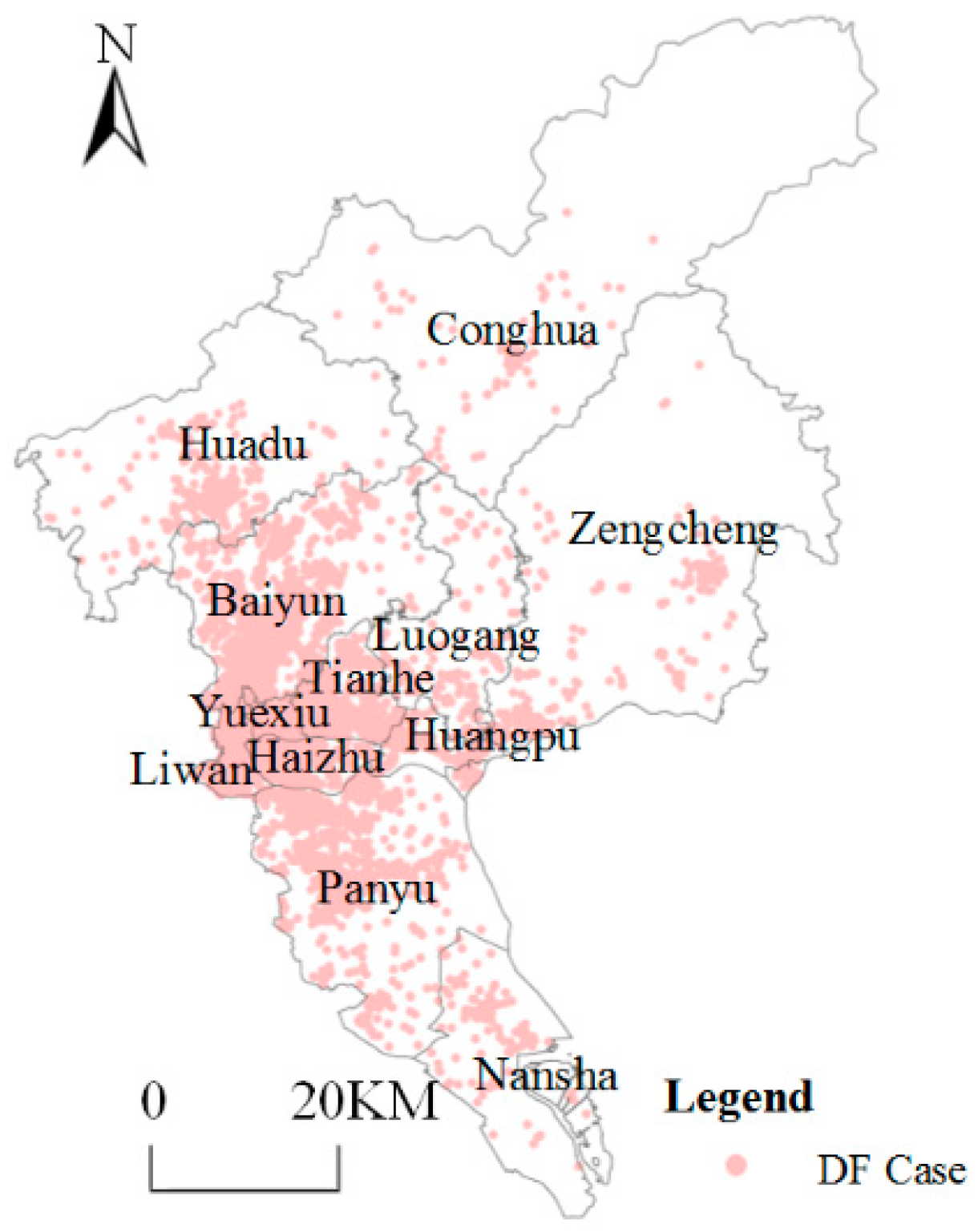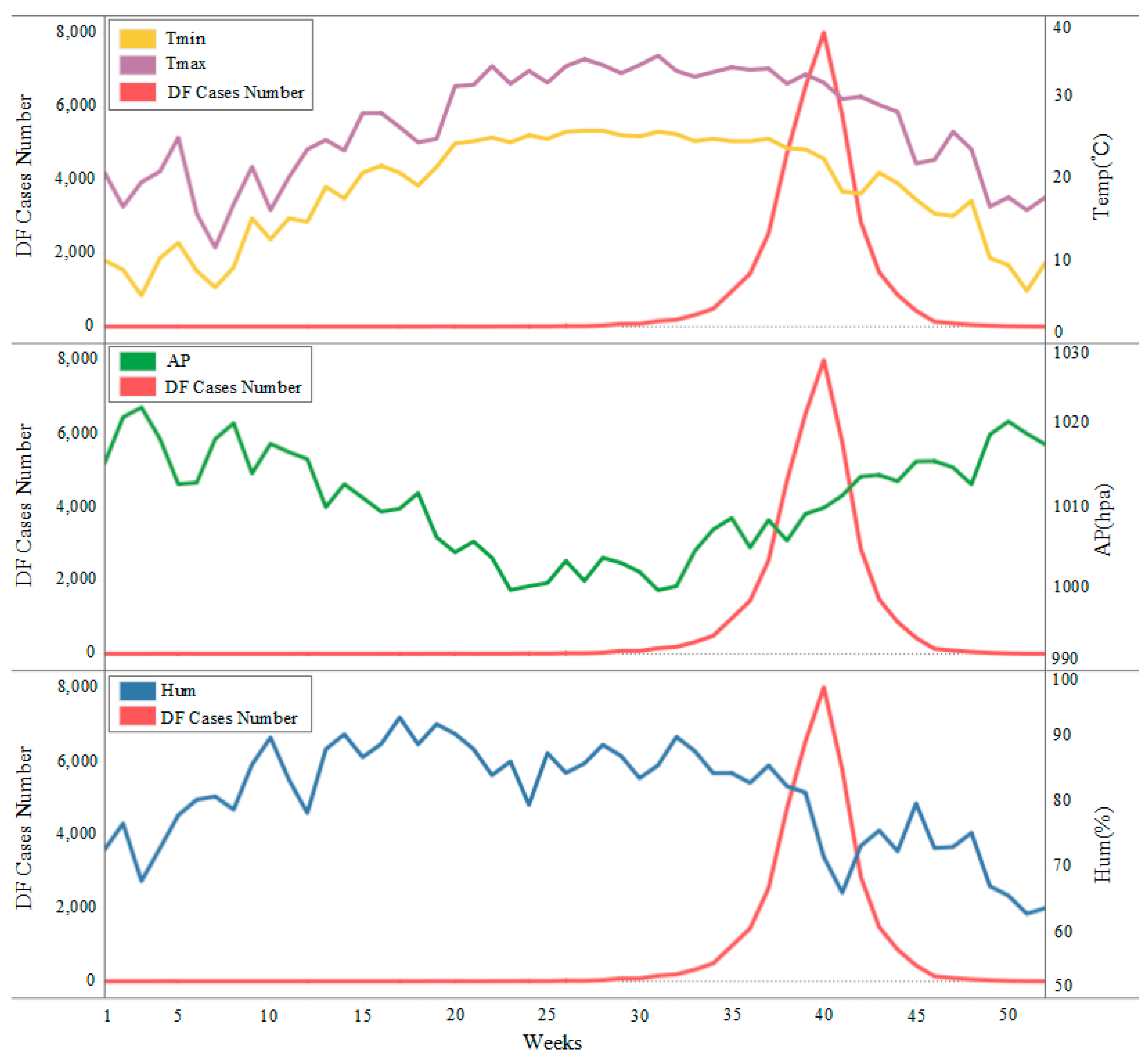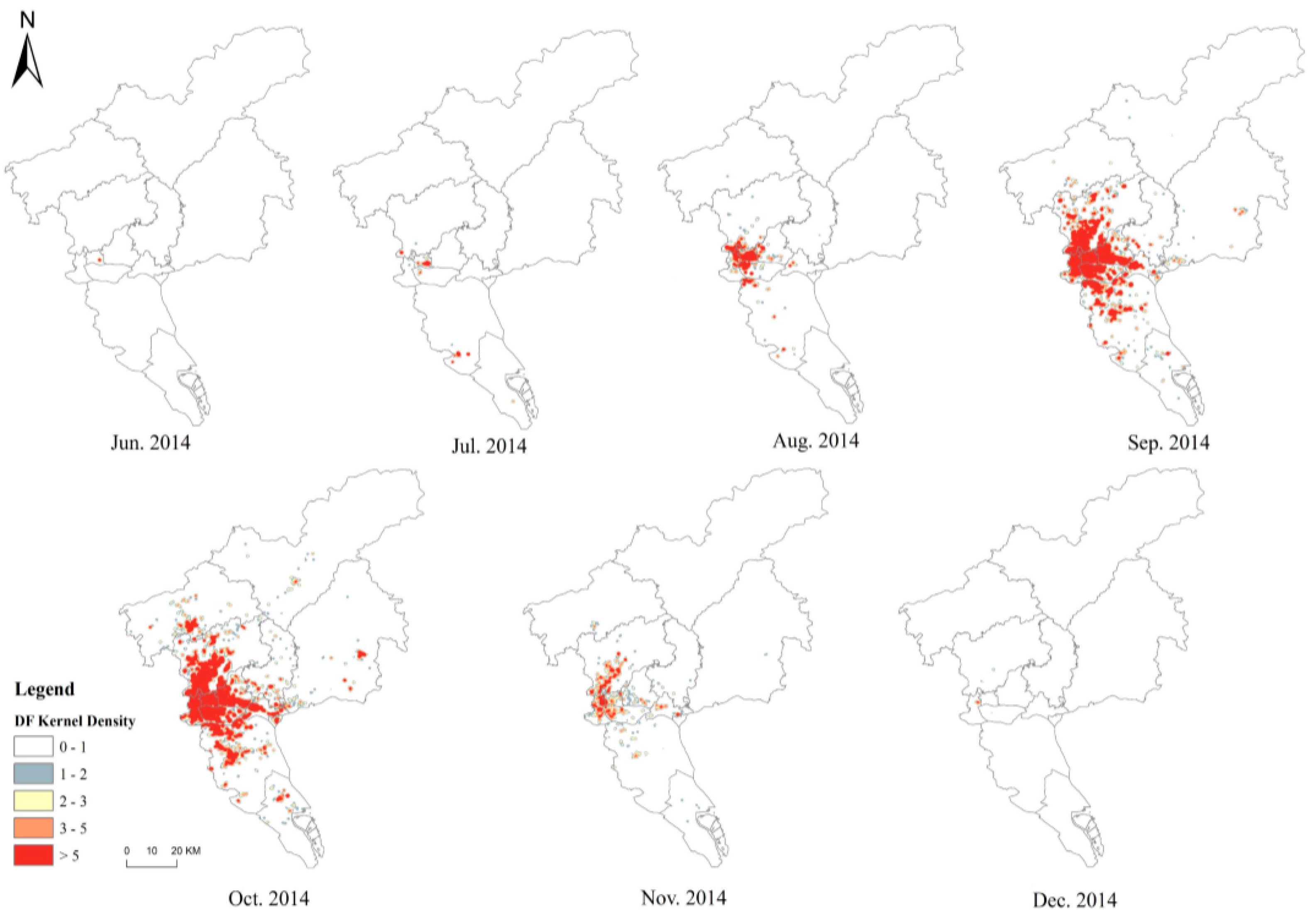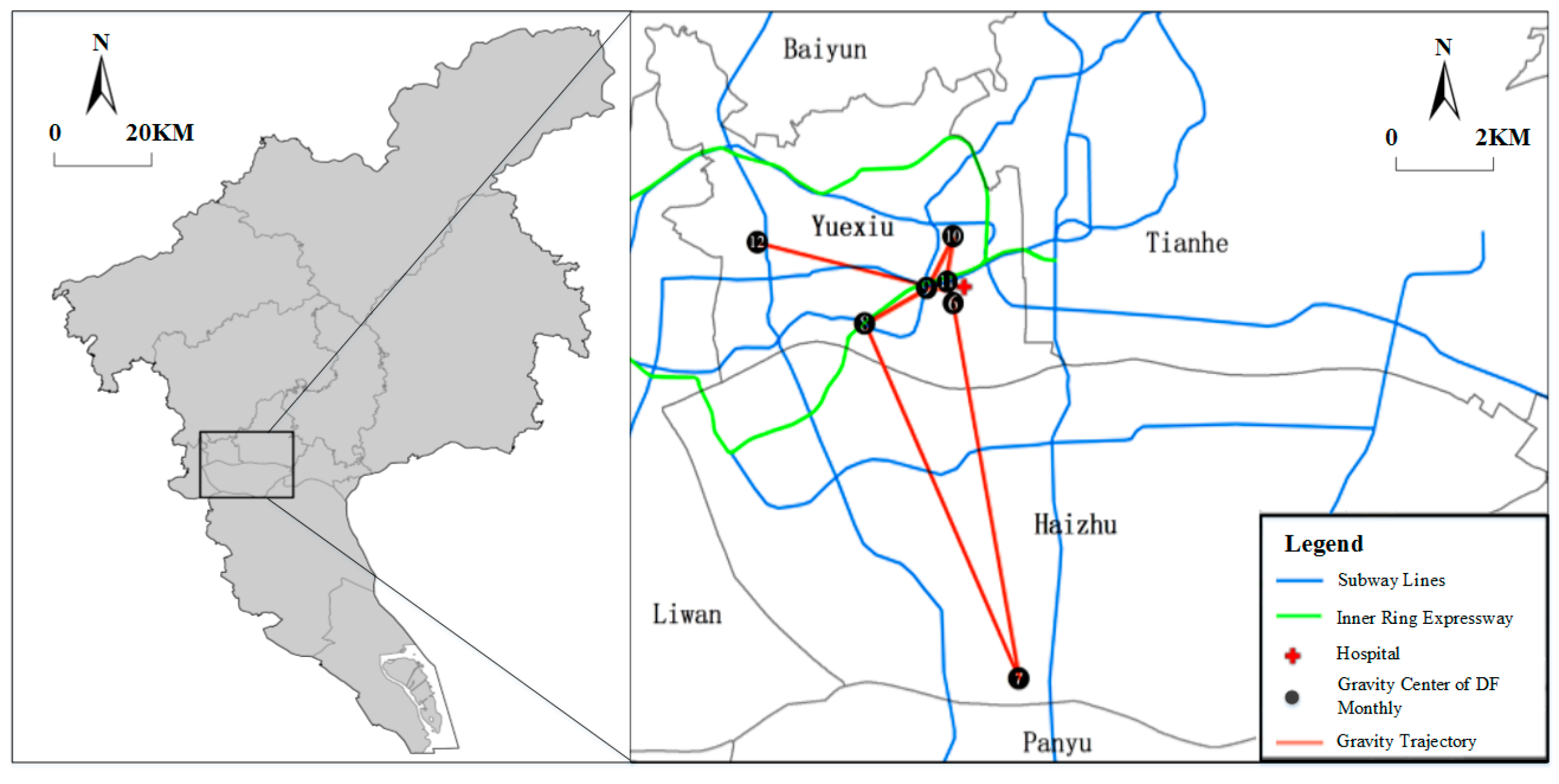Spatiotemporal Transmission Patterns and Determinants of Dengue Fever: A Case Study of Guangzhou, China
Abstract
1. Introduction
2. Materials and Methods
2.1. Study Area
2.2. Data Collection
2.2.1. Dengue Fever Data
2.2.2. Factor Data
2.3. Methodology
2.3.1. Cross-Correlation Analysis
2.3.2. Geo-Detector Analysis
3. Analyses and Results
3.1. Spatiotemporal Transmission Characteristics Analysis
3.2. Relationship between Dengue Fever and Driving Factors
3.2.1. Meteorological Factors
3.2.2. Human and land-Use Factors
4. Discussion
5. Conclusions
Author Contributions
Funding
Acknowledgments
Conflicts of Interest
References
- Bhatt, S.; Gething, P.W.; Brady, O.J.; Messina, J.P.; Farlow, A.W.; Moyes, C.L.; Drake, J.M.; Brownstein, J.S.; Hoen, A.G.; Sankoh, O.; et al. The global distribution and burden of dengue. Nature 2013, 496, 504–507. [Google Scholar] [CrossRef] [PubMed]
- Morin, C.W.; Comrie, A.C.; Ernst, K. Climate and dengue transmission: Evidence and implications. Environ. Health Perspect. 2013, 121, 1264–1272. [Google Scholar] [CrossRef] [PubMed]
- Brady, O.J.; Gething, P.W.; Bhatt, S.; Messina, J.P.; Brownstein, J.S.; Hoen, A.G.; Moyes, C.L.; Farlow, A.W.; Scott, T.W.; Hay, S.I. Refining the global spatial limits of dengue virus transmission by evidence-based consensus. PLoS Negl. Trop. Dis. 2012, 6, e1760. [Google Scholar] [CrossRef] [PubMed]
- Moreno-Madriñán, M.; Crosson, W.; Eisen, L.; Estes, S.; Estes, M., Jr.; Hayden, M.; Hemmings, S.; Irwin, D.; Lozano-Fuentes, S.; Monaghan, A.; et al. Correlating remote sensing data with the abundance of pupae of the dengue virus mosquito vector, Aedes aegypti, in Central Mexico. ISPRS Int. J. Geo-inf. 2014, 3, 732–749. [Google Scholar] [CrossRef]
- Ribeiro, C.F.; Lopes, V.G.S.; Brasil, P.; Pires, A.R.C.; Rohloff, R.; Nogueira, R.M.R. Dengue infection in pregnancy and its impact on the placenta. Int. J. Infect. Dis. 2017, 55, 109–112. [Google Scholar] [CrossRef] [PubMed]
- Wen, T.H.; Lin, M.H.; Teng, H.J.; Chang, N.T. Incorporating the human- Aedes mosquito interactions into measuring the spatial risk of urban dengue fever. Appl. Geogr. 2015, 62, 256–266. [Google Scholar] [CrossRef]
- Lee, H.S.; Nguyen-Viet, H.; Nam, V.S.; Lee, M.; Won, S.; Duc, P.P.; Grace, D. Seasonal patterns of dengue fever and associated climate factors in 4 provinces in Vietnam from 1994 to 2013. BMC Infect. Dis. 2017, 17, 218. [Google Scholar] [CrossRef] [PubMed]
- Li, Q.; Cao, W.; Ren, H.; Ji, Z.; Jiang, H. Spatiotemporal responses of dengue fever transmission to the road network in an urban area. Acta Trop. 2018, 183, 8–13. [Google Scholar] [CrossRef] [PubMed]
- Guzman, M.G.; Harris, E. Dengue. Lancet 2015, 385, 453–465. [Google Scholar] [CrossRef]
- Liu, K.; Sun, J.; Liu, X.; Li, R.; Wang, Y.; Lu, L.; Wu, H.; Gao, Y.; Xu, L.; Liu, Q. Spatiotemporal patterns and determinants of dengue at county level in China from 2005–2017. Int. J. Infect. Dis. 2018, 77, 96–104. [Google Scholar] [CrossRef]
- Scott, T.W.; Morrison, A.C. Vector dynamics and transmission of dengue virus: Implications for dengue surveillance and prevention strategies. Curr. Top. Microbiol. Immunol. 2010, 338, 115–128. [Google Scholar] [PubMed]
- Mahmood, S.; Irshad, A.; Nasir, J.M.; Sharif, F.; Farooqi, S.H. Spatiotemporal analysis of dengue outbreaks in Samanabad town, Lahore metropolitan area, using geospatial techniques. Environ. Monit. Assess. 2019, 191, 55. [Google Scholar] [CrossRef] [PubMed]
- Åström, C.; Rocklöv, J.; Hales, S.; Béguin, A.; Louis, V.; Sauerborn, R. Potential distribution of dengue fever under scenarios of climate change and economic development. Ecohealth 2012, 9, 448–454. [Google Scholar] [CrossRef] [PubMed]
- Savargaonkar, D.; Sinha, S.; Srivastava, B.; Nagpal, B.N.; Sinha, A.; Shamim, A.; Das, R.; Pande, V.; Anvikar, A.R.; Valecha, N. An epidemiological study of dengue and its coinfections in Delhi. Int. J. Infect. Dis. 2018, 74, 41–46. [Google Scholar] [CrossRef] [PubMed]
- Hagenlocher, M.; Delmelle, E.; Casas, I.; Kienberger, S. Assessing socioeconomic vulnerability to dengue fever in Cali, Colombia: Statistical vs expert-based modeling. Int. J. Health Geogr. 2013, 12, 36. [Google Scholar] [CrossRef] [PubMed]
- Sanna, M.; Hsieh, Y.-H. Ascertaining the impact of public rapid transit system on spread of dengue in urban settings. Sci. Total Environ. 2017, 598, 1151–1159. [Google Scholar] [CrossRef] [PubMed]
- Ren, H.; Zheng, L.; Li, Q.; Yuan, W.; Lu, L. Exploring determinants of spatial variations in the Dengue Fever epidemic using geographically weighted regression model: A case study in the joint Guangzhou-Foshan Area, China, 2014. Int. J. Environ. Res. Public Health 2017, 14, 1518. [Google Scholar] [CrossRef] [PubMed]
- Balmaseda, A.; Hammond, S.N.; Perez, L.; Tellez, Y.; Saborio, S.I.; Mercado, J.C.; Cuadra, R.; Rocha, J.; Perez, M.A.; Silva, S.; et al. Serotype-specific differences in clinical manifestations of dengue. Am. J. Trop. Med. Hyg. 2006, 74, 449–456. [Google Scholar] [CrossRef] [PubMed]
- Atique, S.; Chan, T.C.; Chen, C.C.; Hsu, C.Y.; Iqtidar, S.; Louis, V.R.; Shabbir, S.A.; Chuang, T.W. Investigating spatio-temporal distribution and diffusion patterns of the dengue outbreak in Swat, Pakistan. J. Infect. Public Health 2018, 11, 550–557. [Google Scholar] [CrossRef]
- Hsueh, Y.H.; Lee, J.; Beltz, L. Spatio-temporal patterns of dengue fever cases in Kaoshiung City, Taiwan, 2003–2008. Appl. Geogr. 2012, 34, 587–594. [Google Scholar] [CrossRef]
- Santos, C.A.G.; Guerra-Gomes, I.C.; Gois, B.M.; Peixoto, R.F.; Keesen, T.S.L.; da Silva, R.M. Correlation of dengue incidence and rainfall occurrence using wavelet transform for Joao Pessoa city. Sci. Total Environ. 2019, 647, 794–805. [Google Scholar] [CrossRef] [PubMed]
- Kikuti, M.; Cunha, G.M.; Paploski, I.A.; Kasper, A.M.; Silva, M.M.; Tavares, A.S.; Cruz, J.S.; Queiroz, T.L.; Rodrigues, M.S.; Santana, P.M.; et al. Spatial Distribution of Dengue in a Brazilian Urban Slum Setting: Role of Socioeconomic Gradient in Disease Risk. Plos Negl. Trop. Dis. 2015, 9, e0003937. [Google Scholar] [CrossRef] [PubMed]
- World Health Organization. Dengue Guidelines for Diagnosis, Treatment, Prevention and Control; World Health Organization: Geneva, Switzerland, 2009; pp. 14–67. [Google Scholar]
- Xu, H.Y.; Fu, X.; Lee, L.K.H.; Ma, S.; Goh, K.T.; Wong, J.; Habibullah, M.S.; Lee, G.K.K.; Lim, T.K.; Tambyah, P.A.; et al. Statistical Modeling Reveals the Effect of Absolute Humidity on Dengue in Singapore. Plos Negl. Trop. Dis. 2014, 8, e2805. [Google Scholar] [CrossRef] [PubMed]
- Rosa-Freitas, M.G.; Schreiber, K.V.; Tsouris, P.; Weimann, E.T.D.S.; Luitgards-Moura, J.F. Associations between dengue and combinations of weather factors in a city in the Brazilian Amazon. Revista Panamericana Salud Pública 2006, 20, 256–267. [Google Scholar] [CrossRef] [PubMed]
- Chen, Z.; Chen, D.; Xie, X.; Cai, J.; Zhuang, Y.; Cheng, N.; He, B.; Gao, B. Spatial self-aggregation effects and national division of city-level PM2.5 concentrations in China based on spatio-temporal clustering. J. Clean. Prod. 2019, 207, 875–881. [Google Scholar]
- Luo, L.; Mei, K.; Qu, L.; Zhang, C.; Chen, H.; Wang, S.; Di, D.; Huang, H.; Wang, Z.; Xia, F.; et al. Assessment of the Geographical Detector Method for investigating heavy metal source apportionment in an urban watershed of Eastern China. Sci. Total Environ. 2019, 653, 714–722. [Google Scholar] [CrossRef] [PubMed]
- Wang, J.; Zhang, T.; Fu, B. A measure of spatial stratified heterogeneity. Ecol. Indic. 2016, 67, 250–256. [Google Scholar] [CrossRef]
- Wongkoon, S.; Jaroensutasinee, M.; Jaroensutasinee, K. Weather factors influencing the occurrence of dengue fever in Nakhon Si Thammarat, Thailand. Trop. Biomed. 2013, 30, 631–641. [Google Scholar] [PubMed]
- Xiang, J.; Hansen, A.; Liu, Q.; Liu, X.; Tong, M.X.; Sun, Y.; Cameron, S.; Hanson-Easey, S.; Han, G.S.; Williams, C.; et al. Association between dengue fever incidence and meteorological factors in Guangzhou, China, 2005–2014. Environ. Res. 2017, 153, 17–26. [Google Scholar] [CrossRef] [PubMed]
- Bultó, P.L.O.; Rodríguez, A.P.; Valencia, A.R.; Vega, N.L.; Gonzalez, M.D.; Carrera, A.P. Assessment of Human Health Vulnerability to Climate Variability and Change in Cuba. Environ. Health Perspect. 2007, 114, 1942–1949. [Google Scholar] [CrossRef] [PubMed]
- Bakhsh, K.; Sana, F.; Ahmad, N. Dengue fever in Punjab, Pakistan: Knowledge, perception and adaptation among urban adults. Sci. Total Environ. 2018, 644, 1304–1311. [Google Scholar] [CrossRef] [PubMed]
- Silva, M.M.; Rodrigues, M.S.; Paploski, I.A.; Kikuti, M.; Kasper, A.M.; Cruz, J.S.; Queiroz, T.L.; Tavares, A.S.; Santana, P.M.; Araujo, J.M.; et al. Accuracy of dengue reporting by national surveillance system, Brazil. Emerg. Infect. Dis. 2016, 22, 336–339. [Google Scholar] [CrossRef] [PubMed]
- Li, Z.; Roux, E.; Dessay, N.; Girod, R.; Stefani, A.; Nacher, M.; Moiret, A.; Seyler, F. Mapping a knowledge-based malaria hazard index related to landscape using remote sensing: Application to the cross-border area between French Guiana and Brazil. Remote Sens. 2016, 8, 319. [Google Scholar] [CrossRef]





| Factor Type | Variables | Description | Unit |
|---|---|---|---|
| Meteorological Data | Minimum Temperature | Daily minimum temperature | °C |
| Maximum Temperature | Daily maximum temperature | °C | |
| Atmospheric Pressure | Daily atmospheric pressure | hPa | |
| Relative Humidity | Daily relative humidity | % | |
| Human Data | Population | Number of people on the building | - |
| Community age | Time span from the completion of the residential community to 2014 | Years | |
| Land-use Data | Road | Road network density | km/km2 |
| Subway | Subway lines network density | km/km2 | |
| Ponds | Ponds area | m2 |
| Lag Weeks | 0 | 1 | 2 | 3 | 4 | 5 | 6 | 7 | 8 | 9 | 10 | 11 | 12 |
|---|---|---|---|---|---|---|---|---|---|---|---|---|---|
| Tmin (°C) | 0.480 ** | 0.551 ** | 0.624 ** | 0.703 ** | 0.765 ** | 0.801 ** | 0.849 ** | 0.894 ** | 0.913 ** | 0.927 ** | 0.945 ** | 0.935 ** | 0.890 ** |
| Tmax (°C) | 0.588 ** | 0.642 ** | 0.712 ** | 0.783 ** | 0.833 ** | 0.850 ** | 0.878 ** | 0.917 ** | 0.901 ** | 0.882 ** | 0.862 ** | 0.840 ** | 0.786 ** |
| AP (hpa) | −0.360 ** | −0.414 ** | −0.488 ** | −0.593 ** | −0.649 ** | −0.705 ** | −0.787 ** | −0.836 ** | −0.859 ** | −0.895 ** | −0.916 ** | −0.920 ** | −0.890 ** |
| Hum (%) | −0.203 | −0.155 * | −0.07 | 0.017 | 0.049 | 0.139 | 0.239 | 0.273 | 0.329 * | 0.42 ** | 0.495 ** | 0.493 ** | 0.523 ** |
| Factor | Population | Community Age | Subway | Road | Ponds |
|---|---|---|---|---|---|
| q | 0.624 | 0.382 | 0.134 | 0.050 | 0.001 |
| p | 0.01 | 0.01 | 0.01 | 0.01 | 0.04 |
| Factor | Population | Community Age | Subway | Road | Ponds |
|---|---|---|---|---|---|
| Population | 0.624 | ||||
| Community Age | 0.658 | 0.382 | |||
| Subway | 0.643 | 0.421 | 0.134 | ||
| Road | 0.640 | 0.413 | 0.183 | 0.050 | |
| Ponds | 0.625 | 0.388 | 0.146 | 0.058 | 0.003 |
© 2019 by the authors. Licensee MDPI, Basel, Switzerland. This article is an open access article distributed under the terms and conditions of the Creative Commons Attribution (CC BY) license (http://creativecommons.org/licenses/by/4.0/).
Share and Cite
Chen, Y.; Zhao, Z.; Li, Z.; Li, W.; Li, Z.; Guo, R.; Yuan, Z. Spatiotemporal Transmission Patterns and Determinants of Dengue Fever: A Case Study of Guangzhou, China. Int. J. Environ. Res. Public Health 2019, 16, 2486. https://doi.org/10.3390/ijerph16142486
Chen Y, Zhao Z, Li Z, Li W, Li Z, Guo R, Yuan Z. Spatiotemporal Transmission Patterns and Determinants of Dengue Fever: A Case Study of Guangzhou, China. International Journal of Environmental Research and Public Health. 2019; 16(14):2486. https://doi.org/10.3390/ijerph16142486
Chicago/Turabian StyleChen, Yebin, Zhigang Zhao, Zhichao Li, Weihong Li, Zhipeng Li, Renzhong Guo, and Zhilu Yuan. 2019. "Spatiotemporal Transmission Patterns and Determinants of Dengue Fever: A Case Study of Guangzhou, China" International Journal of Environmental Research and Public Health 16, no. 14: 2486. https://doi.org/10.3390/ijerph16142486
APA StyleChen, Y., Zhao, Z., Li, Z., Li, W., Li, Z., Guo, R., & Yuan, Z. (2019). Spatiotemporal Transmission Patterns and Determinants of Dengue Fever: A Case Study of Guangzhou, China. International Journal of Environmental Research and Public Health, 16(14), 2486. https://doi.org/10.3390/ijerph16142486





